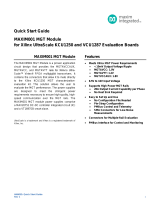Xilinx Virtex-5 FXT is an FPGA (Field Programmable Gate Array) prototype platform that provides a comprehensive development environment for designing, prototyping, and testing complex digital systems. With its advanced features and capabilities, the Virtex-5 FXT empowers engineers to accelerate their innovation and bring their ideas to life.
The Virtex-5 FXT is equipped with the latest Virtex-5 FPGA technology, offering exceptional processing power and flexibility.
Xilinx Virtex-5 FXT is an FPGA (Field Programmable Gate Array) prototype platform that provides a comprehensive development environment for designing, prototyping, and testing complex digital systems. With its advanced features and capabilities, the Virtex-5 FXT empowers engineers to accelerate their innovation and bring their ideas to life.
The Virtex-5 FXT is equipped with the latest Virtex-5 FPGA technology, offering exceptional processing power and flexibility.


















-
 1
1
-
 2
2
-
 3
3
-
 4
4
-
 5
5
-
 6
6
-
 7
7
-
 8
8
-
 9
9
-
 10
10
-
 11
11
-
 12
12
-
 13
13
-
 14
14
-
 15
15
-
 16
16
-
 17
17
-
 18
18
-
 19
19
-
 20
20
-
 21
21
-
 22
22
-
 23
23
-
 24
24
-
 25
25
-
 26
26
-
 27
27
-
 28
28
-
 29
29
-
 30
30
Xilinx Virtex-5 FXT User manual
- Type
- User manual
- This manual is also suitable for
Xilinx Virtex-5 FXT is an FPGA (Field Programmable Gate Array) prototype platform that provides a comprehensive development environment for designing, prototyping, and testing complex digital systems. With its advanced features and capabilities, the Virtex-5 FXT empowers engineers to accelerate their innovation and bring their ideas to life.
The Virtex-5 FXT is equipped with the latest Virtex-5 FPGA technology, offering exceptional processing power and flexibility.
Ask a question and I''ll find the answer in the document
Finding information in a document is now easier with AI
Related papers
-
Xilinx ML523 User manual
-
Xilinx Virtex-II Pro User manual
-
Xilinx Virtex-4 RocketIO Configuration User Manual
-
Xilinx Virtex-5 FPGA ML561 User manual
-
Xilinx Virtex-5 User manual
-
Xilinx Virtex-6 FPGA User manual
-
Xilinx 7 Series User manual
-
Xilinx 1000BASE-X User manual
-
Xilinx ML505 User manual
-
Xilinx ML507 User manual
Other documents
-
Beam LBT9522B Owner's manual
-
Cadence ALLEGRO FPGA SYSTEM PLANNER System Planner
-
Adcom GTP-870HD User manual
-
Microsemi ZLE30267 User manual
-
Crown P.I.P.-FXT Owner's manual
-
 Maxim Integrated MAXIM001 MGT Quick start guide
Maxim Integrated MAXIM001 MGT Quick start guide
-
Digilent JTAG-HS2 Reference guide
-
Texas Instruments Demonst SMPTE-Compliant SDI Out Jittr Using LMH1982 & Virtx-5 GTP Xmittr (Rev. A) Application notes
-
Cadence CADENCE ORCAD FPGA SYSTEM PLANNER System Planner
-
Connect Tech PCI-104 User manual
































